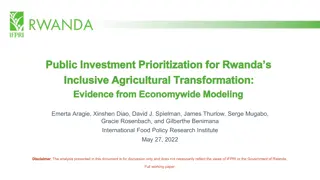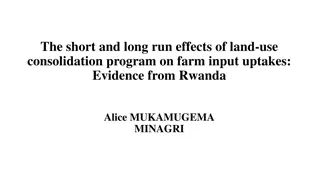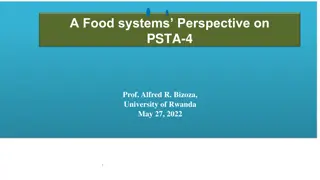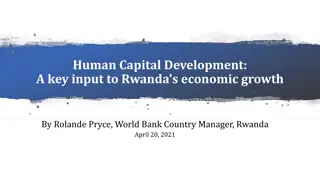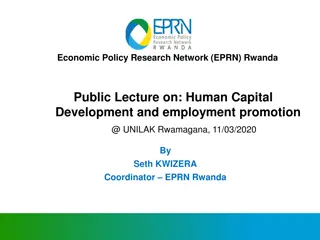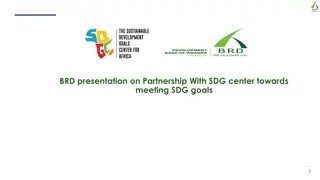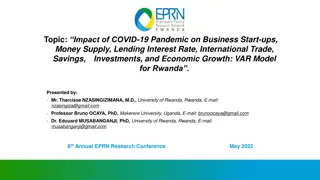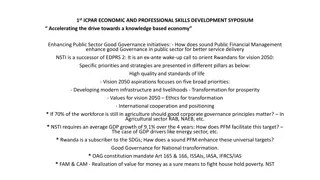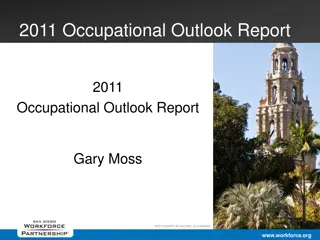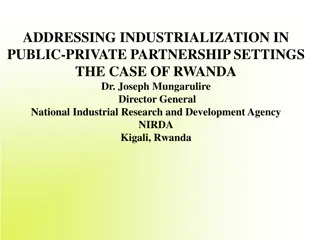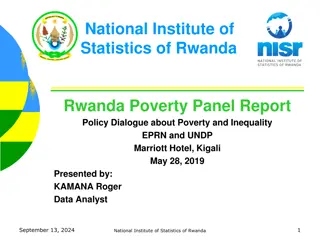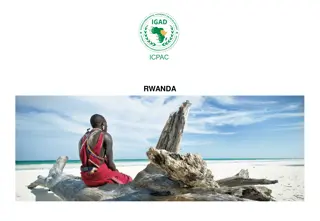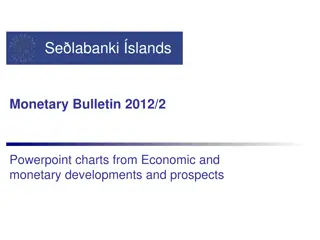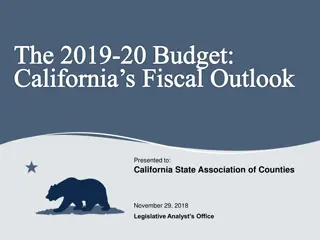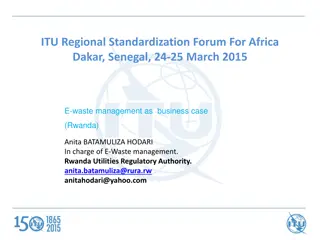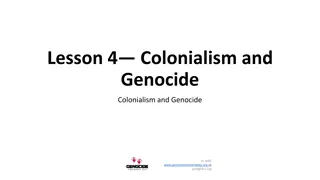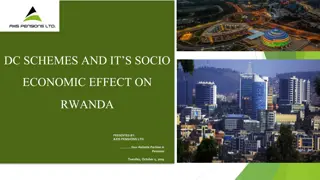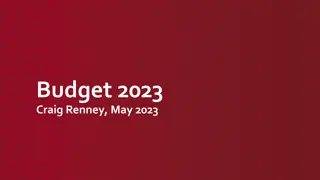Rwanda Economic Developments and Outlook Overview
Rwanda's economic outlook for 2019 includes moderate global growth prospects amidst trade tensions, Brexit, and global uncertainty. The country's GDP growth stood at 8.6% in 2018, supported by favorable weather conditions, public infrastructure investments, and continued global demand. Inflation rates in advanced and emerging economies are projected to vary, influencing commodity prices, particularly crude oil. The domestic economic performance in Rwanda has been positive, with growth in sectors like agriculture, services, and industry contributing to the overall expansion.
Download Presentation

Please find below an Image/Link to download the presentation.
The content on the website is provided AS IS for your information and personal use only. It may not be sold, licensed, or shared on other websites without obtaining consent from the author. Download presentation by click this link. If you encounter any issues during the download, it is possible that the publisher has removed the file from their server.
E N D
Presentation Transcript
Rwanda Economic Developments and Outlook 23rdMay, 2019 1
OUTLINE 1. International economic environment 2. Domestic economic performance 3. Economic outlook and policy orientation
OVERVIEW ON GLOBAL ECONOMIC ENVIRONMENT Moderate global growth prospects for 2019 following trade tensions, Brexit and global uncertainty Economic growth (selected regions and countries) 7.5 8 7.3 6.6 7 6.3 6.2 5.9 6 5 3.5 4 2.9 2.9 3 2.5 1.6 1.5 1.1 2 1.8 1.4 0.9 1 0 USA Euro Area UK JP China India SSA EAC 2018 est. 2019 proj. EAC economic growth, supported by: Continued global demand (though softening); Favorable weather conditions; Public infrastructure investments.
ANNUAL INLATION DEVELOPMENTS Advanced economies: 21.0 Estimated at 2.0% (2018) and projected at 1.6% (2019), from 1.7% (2017) 16.0 Global inflation: Estimated at 3.6% (2018 & 2019) up from 3.2% (2017) 11.0 6.0 Emerging and developing economies: 1.0 4.8% (2018) and 4.7% (2019) from 4.3% (2017) -4.0 -9.0 Jan-15 Jun-15 Nov-15 Apr-16 Sep-16 Feb-17 Jul-17 Dec-17 May-18 Oct-18 Mar-19 Sub-Saharan: 8.5% in 2018 and 8.1% in 2019, from 11.0% in 2017; Uganda Kenya Tanzania Rwanda Burundi EAC: 5.3% in 2018 and 5.0% in 2019 from 4.0% in 2017
DEVELOPMENTS FOR COMMODITY PRICES Crude oil prices: fell by 9.2% on average (Jan-Feb. 2019) from 20.1% (in 2018) Global energy index: fell by 8.7% in Jan.- Feb. 2019 from 19.5%, and projected to slightly increase by 1.4% in 2019 and fell by 6.7% in 2020; Non-energy index: -6.5% after +3.4%; Metals & minerals prices (-12.0% from +16.2%) Tin: -1.5% from +5.5%; Agriculture prices: -4.7% from -1.7%; Food: -5.0% from -0.2%; Fertilizers: +12.1% from -0.3% Crude oil prices projected to decrease by 14.1% in 2019 and 0.4% in 2020 . Moderate performance of export (due to softening global demand) Imported inflation pressures due to weakening FRW Slight pick up of Inflation Expected Impact of global economy on Rwandan Economy Easing import bill growth (but still high) due to falling oil prices
DOMESTIC CONOMIC PERFORMANCE GDP Growth: 8.6% in 2018 (vs 7.2% projected) and around 7.8% (2019 proj.) Favorable weather condition Good performance of trade and transport services Recovery in construction sector (due to ongoing infrastructure projects) Agriculture: 5.9% (2018) vs 6.6% (2017) Service: (+1.6 pcp) Industry: 8.8% (2018) vs 7.9%(2017) 10.3% (2018) vs 4.5% (2017) (+4.3 pcp) (+1.8 pcp) GDP growth: Improvement in manufacturing (beverages, textiles, non-metallic minerals (o.w cement) and metals) Hotel industry (backed by improvement in tourism); Telecommunication; Financial services. 8.6% (2018) vs 6.1% (2017) & 6.0% (2016) In Jan. 2019: turnovers (31.8% vs 21.8%); CIEA (10.6% vs 16.3%) continued good performance (lower level)
DOMESTIC CONOMIC PERFORMANCE Trade balance Rwanda s formal trade deficit has increased by 6.6 percent in first Quarter of 2019 compared to the same period of last year, the expansion in trade deficit is on the account of increases in formal imports by 3.5 percent against a decline in formal exports (-1.4 percent). TRADE BALANCE Exports Imports Trade Balance 3000.0 2425.0 2223.3 2215.4 2000.0 995.7 943.5 858.1 754.4 598.8 1000.0 315.4 298.0 0.0 -1000.0 -456.4 -542.7 -1271.8 -2000.0 -1429.3 -1624.5 2016 2017 2018 Jan - Apr 2018 Jan - Apr 2019
DOMESTIC ECONOMIC PERFORMANCE International trade developments: The 3.5% growth in imports in Q1 2019 is mainly attributed to a high imports of consumer goods; mainly Non-food products like Health care products (+36.3%), high imports of non-transport capital goods (+7.5%) and construction materials like Cement (+24.2%) and metals (+41.5%) following huge infrastructure investment including Bugesera airports, peat power plant in Gisagara districts, roads etc. Rwanda s formal exports revenue decreased by 1.4 percent while the volume slightly increased by 4.4 percent. The negative growth in Exports value is mainly attributed to a negative growth in traditional export (-13.9%) driven by the sharp decline in commodity prices for some commodities such as tea (-17.0%) and Coltan (-12.2%). And significant decrease in volume export for coffee (-12.2%), Cassiterite (-7.3%) compared to same period in 2018. Imports developments in Mln USD Exports developments in Mln USD 140 100 90 120 80 100 70 Millions USD Millions USD 60 Q1 2018 80 50 Q1 2018 60 40 Q1 2019 30 Q1 2019 40 20 20 10 0 0 Consumer goods Capital goods Intermediate Energy and lubricants Traditional Export Non-Traditional exports Re-Exort goods
MONETARY AGGREGATES DEVELOPMENTS In 2019Q1/2018Q1 (yoy): Credit to the private sector (+16.2%); New authorized loans (+24.9%). Growth in credit to private sector (%) 50.0 38.2 40.0 30.0 30.0 24.9 19.6 17.2 16.2 20.0 13.9 13.7 10.8 9.1 7.3 6.2 10.0 4.6 0.0 -10.0 -7.4 CPS NALs
INFLATION DEVELOPMENTS Inflation has been low since 2018 and continues to remain low at 1% in 2019Q1. A similar situation occurred in 2015Q1, as a result of food deflation and decreased oil prices Headline_Average (12months) Upper Band Lower Band Core_Average (12months) 9.0 8.0 7.0 6.0 5.0 4.0 3.0 2.0 1.0 0.0
Real Sector Growth Outlook 2017 6.1% 7% 7% 2% 5% 23% 2018 8.6% 6% 4% 10% 10% 2% 2019 8.0% 5.5% 5.1% 5.8% 11.0% 18.1% 2020 8.2% 5.2% 5.1% 2.6% 11.5% 19.0% 2021 MT average 8.4% 5.5% 5.1% 7.8% 11.8% 18.5% GDP AGRICULTURE Food crops Export crops INDUSTRY Mining & quarrying 8.2% 5.4% 5.1% 5.4% 11.4% 18.5% TOTAL MANUFACTURING Manufacturing of food Manufacturing of beverages & tobacco Manufacturing of textiles, clothing & leather goods Construction SERVICES Trade and Transport Maintenance & repair of motor vehicles Wholesale & retail trade Transport services Other services Hotels & restaurants Information & communication Financial services Professional, scientific and technical activities 7% 14% -8% 22% -3% 8% 4% 4% 0% 11% 9% 10% 12% 7% 17% 11% 9% 9% 20% 14% 9% 16% 7% 15% 18% 7% 10% 18% 10% 6% 8.7% 6.0% 4.3% 17.2% 10.5% 8.4% 6.4% 5.7% 5.8% 7.6% 9.1% 10.0% 14.2% 8.2% 11.0% 9.0% 5.1% 6.6% 19.7% 10.9% 8.5% 7.5% 6.4% 7.0% 8.4% 8.8% 9.4% 14.3% 8.1% 10.1% 9.5% 5.3% 6.6% 18.9% 11.1% 8.5% 7.7% 6.0% 7.2% 8.7% 8.8% 14.1% 14.7% 8.3% 11.1% 9.1% 5.5% 5.8% 18.6% 10.8% 8.5% 7.2% 6.0% 6.7% 8.2% 8.9% 11.2% 14.4% 8.2% 10.7%
Real Sector Outlook The economy is projected to grow by 8.0 per cent in the medium term with a 7.8 percent growth in 2019. The agriculture sector is expected to get good performance in food and export crops due to continuing investments to improve seeds and extend irrigation. However, projections remain moderate at 5.4 per cent on average in the medium term as our Agriculture sector remains dependent on weather conditions, which are highly unpredictable .
Real Sector Outlook The industry is expected to grow by 11 per cent in 2019 and 11.6 per cent on average in the medium term mainly boosted by mining and construction. The construction sector is set to register a good performance in 2019 and 2020 with 10.5 and 12.2 per cent respectively, explained by the construction of Bugesera Airport, industrial parks in secondary cities and roads as well as other construction projects from the private sector. The services sector is likely to sustain the good performance for 2019 and 2020 as well as 2021 with 8.0, 8.2 and 8.2 per cent respectively .
Inflation Outlook The central Bank is projecting inflation to rise around 3.0 percent in 2019 on average, which will be supported by the decision to reduce the CBR to 5 percent and the depreciation of FRW that is projected to reach 5.0 percent by end 2019 Nevertheless the recent Geo-Political developments between US and Iran brought some risks to the initial projections, expected to affect domestic prices through a rise in global oil prices.
External sector Outlook In medium term 2019, and 2020 the current account deficit is expected to slightly deteriorate to 9.4 and 10.1 per cent of GDP due to expected higher imports for Bugesera International Airport and for construction projects in general, before reducing to 8.8 per cent of GDP after completion of some of these projects . However, exports of goods are expected to continue increasing especially traditional export due to increasing productivity of coffee production, construction of new tea factories Nyaruguru, Karongi & Nyamasheke by 2021. Investment on 250 ha for vegetables, 65 ha in flowers are expected to significantly boost horticulture exports. Coltan refinery and tin smelter projects will also add value to mineral exports. Exports are expected to increase respectively by 11.2, 14.1 and 19.0 per cent in 2019, 2020 and 2021.
External sector Outlook In the Financial account, foreign direct investments are expected to continue increasing in the medium term especially in 2019 and 2020 explained by expected high investment in Bugesera Airport. The expected increase in foreign direct investment and debt flows in medium term will boost the overall external position to reserve build-up of USD 109.2; USD 160.2 and USD 107.7 million in three years ahead 2019, 2020 and 2021 respectively.
OUTLOOK AND POLICY ORIENTATION Fiscal policy for the Government in 2019/20 and in the medium term will seek to achieve a medium term fiscal path that allows for more spending to reach the NST goals whilst maintaining public debt at a sustainable level. The monetary policy stance is expected to remain accommodative, in a context of low and stable inflation, subdued exchange rate pressures and non-inflationary aggregate demand. Inflation is projected to be around 3.0 per cent on average, in line with the benchmark inflation band.



